Join More Than 50,000+ Subscribers and get latest camera news and rumors
NEW CAMERA VIDEOS ON YOUTUBE
|
By admin, on December 10th, 2024
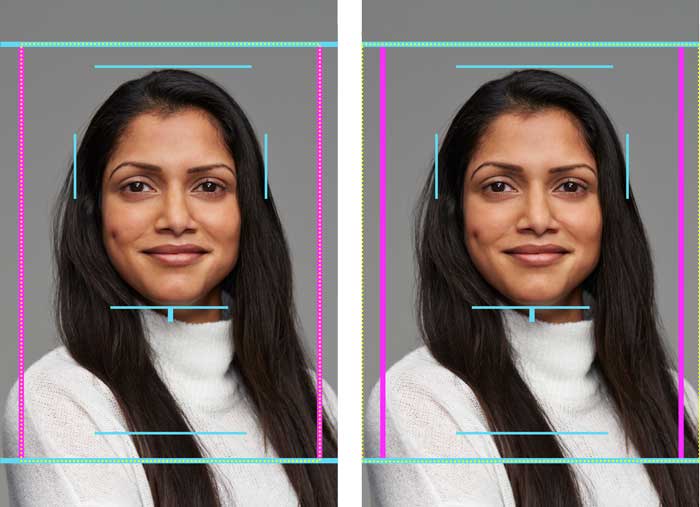
Canon Introduces On-Screen Cropping Guides for the EOS R50, R10, and R7 cameras. These guides will help you compose your images and videos for Instagram or YouTube reels. Take a look at what you will be getting in the latest firmware update from Canon
Key Points: Canon’s New Cropping Guide for EOS Cameras
- Announcement Date and Purpose
- Canon announced a new Cropping Guide feature for select EOS cameras to help users frame subjects precisely and save editing time.
- Compatible Models
- Available for Canon EOS R50, EOS R10, and EOS R7 via firmware update.
- Feature Highlights
- Provides four tailored on-screen cropping guides for better framing.
- Designed for horizontal and vertical framing.
- Targets applications like school photography, sports events, and other scenarios needing consistent subject positioning.
- Availability and Pricing
- Released on December 9, 2024, for $120 USD.
- Current users can send their cameras to a Canon Service Center for installation.
- New cameras pre-loaded with the feature can be purchased via Canon Direct and other dealers for an additional cost.
- Showcase Event
- The feature will be demonstrated at the School Photographers Association of California (SPAC) trade show from January 21-25, 2025, in Las Vegas.
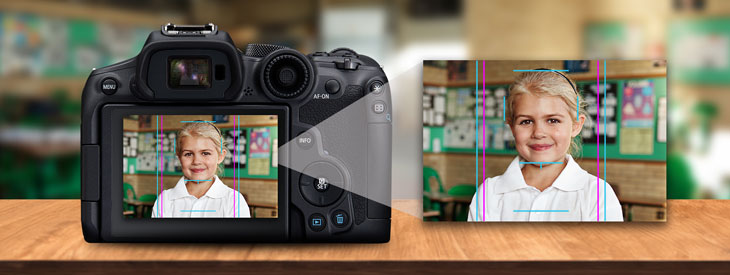
PRESS RELEASE
Canon Launches New Cropping Guide for Select EOS Cameras, Empowering Customers to Capture Beautifully Optimized Photos
MELVILLE, NY, December 9, 2024 – Canon Inc., the parent company of Canon U.S.A., Inc., a leader in digital imaging solutions, announced today a new Cropping Guide feature that will be available via a firmware update for the Canon EOS R50, EOS R10 and EOS R7 camera models that allows users to more easily frame their subjects through the use of four tailored on-screen guides. The new feature will be available on December 9th from Canon USA for USD 120. Customers who have previously purchased one of the camera models compatible with the feature can send their device to a Canon Service Center and it will be returned with the Cropping Guide feature installed. For those new customers interested in the above-mentioned models, the option to purchase them pre-loaded with the feature (for an additional cost) will be available via Canon Direct and other dealers starting December 9th.
The new Cropping Guide feature provides on-screen guidelines that help shooters position subjects with precision, helping to ensure consistent and professional results while saving time on editing. It allows Canon users to position the frame at the time of capture so that post-production and editing can be kept at a minimum. Lastly, the Cropping Guides can be applied to horizontal or vertical framing scenarios, allowing for a wide range of shooting situations.
Canon will showcase its new offering to visitors to the School Photographers Association of California (SPAC) trade show from January 21-25 in Las Vegas, NV at the South Point Hotel and Casino at Booth #715. This new feature is specifically designed for school photography, sports events, or any scenario in which subjects need to maintain a consistent position.
Availability
The Cropping Guide will be available on December 9th. Please visit here for additional information about the software, a list of compatible cameras, and instructions on how to access the Cropping Guide.
Get LIVE RUMORS –> FACEBOOK | TWITTER | INSTAGRAM to get live Camera News +
The post “Canon Introduces On-Screen Cropping Guides for EOS R50, R10, and R7” appeared first on The new camera.com
By admin, on December 8th, 2024

Canon R1 at B&H Store and Amazon.com
Canon R1 Hits Number One: In November 2024’s Camera Sales Trends, Canon R1 scored in the top spot in Japan’s Yodobashi Camera ranking. The good news is not only R1, we have the OS R5 Mark II (4th), EOS R50 (6th), and EOS R6 Mark II (7th).
Sales Ranking
1st Place: Canon EOS R1 (Body Only)
2nd Place: Fujifilm X-M5 with XC15-45mm F3.5-5.6 OIS PZ Lens Kit
3rd Place: Sony α7C II (Body Only)
4th Place: Canon EOS R5 Mark II (Body Only)
5th Place: Sony α7C II with Zoom Lens Kit
6th Place: Canon EOS R50 Double Zoom Kit
7th Place: Canon EOS R6 Mark II (Body Only)
8th Place: Sony α7R V (Body Only)
9th Place: Sony VLOGCAM ZV-E10 II with Double Zoom Lens Kit
10th Place: Nikon Z30 with Double Zoom Lens Kit
After Canon R1 the most-sold camera in Japan is the Fuji X-M5, Fuji does have very strong presence in Japan and the Asian markets.
Sony is steady but a bit slow with its models and needs to refresh its entry-level lineup since the A6400 and A6100 have been due for an update for a long time. The A7C II has scored 3rd and 5th place (with kit). But the surprising thing is that in the list, we do not have the recently announced ZV-E10 Mark II camera, which was expected to be there.
Nikon is struggling to maintain its position in the ranking. The Nikon Z30 with Double Zoom Kit is in 10th place, while the Z8 and Z6 Mark III have dropped from the rankings. The Z50 II may or might not improve Nikon’s position, but it is not on the list yet. So, it’s not a good situation for Nikon right now, specifically in Japan.
Get LIVE RUMORS –> FACEBOOK | TWITTER | INSTAGRAM to get live Camera News 24X7
By admin, on December 6th, 2024
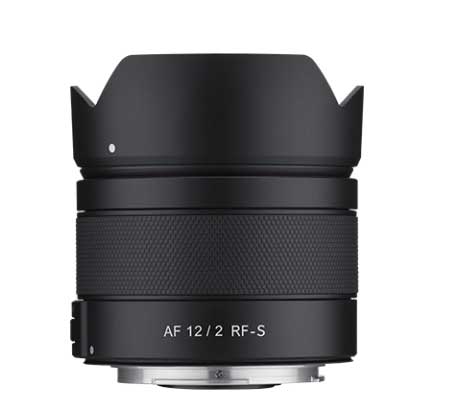
Samyang officially announced its first APS-C lens for Canon RF mount, and this starts a new partnership between the new-age Canon RF series cameras and Samyang, the lens maker. We know that Samyang makes amazing lenses, but unfortunately, the mount was locked for so long. Even now, it’s not completely open; only a few selected third-party lenses not in Canon’s own RF lens lineup are allowed to be in the market after sharing a decent profit. The thing is, at least we have started getting third-party lenses for the RF mount, and that’s the best part.
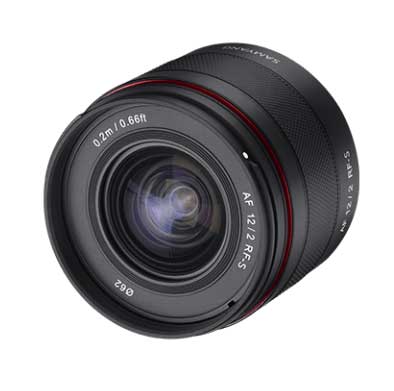
Samyang AF 12mm F2 RF-S Lens Specifications
- Focal Length: 12mm (19mm equivalent on APS-C)
- Maximum Aperture: f/2
- Lens Construction: 12 elements in 10 groups
- Includes 3 ED elements, 1 H-ASP, and 1 ASP element
- Angle of View: 99.1° (diagonal)
- Minimum Focus Distance: 0.2 meters (7.87 inches)
- Autofocus System: Samyang Linear STM (stepping motor)
- Aperture Blades: 7 (starburst effect)
- Maximum Magnification: 0.09x
- Dimensions: 57.2 mm (length)
- Weight: 213 g (7.5 oz)
- Filter Size: 62 mm
- Special Features:
- Weather-sealed
- AF/MF switch
- Matte finish with red ring design
- Compatibility: Canon RF-S mount (APS-C cameras)
- Target Use: Landscape, architecture, astrophotography, and travel
Get LIVE RUMORS –> FACEBOOK | TWITTER | INSTAGRAM to get live Camera News + Canon rumors 24X7
By admin, on November 30th, 2024
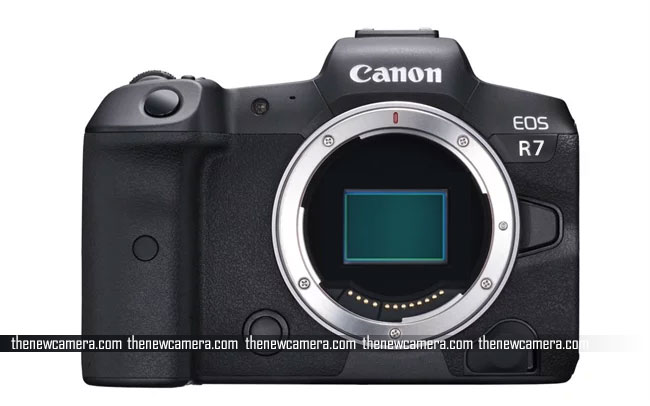
Canon will add 4K 120fps video recording capability to Canon R6 III as well as Canon R7 Mark II in 2025. According to the latest rumors, Canon is testing out the Canon R7 Mark II camera body prototypes, here is what surfaced over the web a while ago. “Despite the tech. designed to maintain DR and low-light performance, the sensor readout speed is impressively fast. With the Digic accelerator, it supports 4K at 120 FPS, but cropping happens in HQ mode. However, is that when you enable pixel binning, you can record 4K at 120 FPS without any cropping.”
One thing, if the above is true then the Canon R7 Mark II, without a doubt a video beast, even Sony FX30 does crop at 4k 120fps.
Stay tuned we will update you as soon as we get any new information
Get LIVE RUMORS –> FACEBOOK | TWITTER | INSTAGRAM to get live Camera News + Canon rumors 24X7
By admin, on November 16th, 2024
After reading this patent, we were really very much surprised that Canon is still working on their compact cameras. Specifically, I am talking about the G7 X series STYLE compacts, which were made for content creation and photography. The new generation of G7 X-style compacts in the patent features a unique electronic viewfinder design that we have never seen before. And Even some of them features DUAL DISPLAY along with EVF.
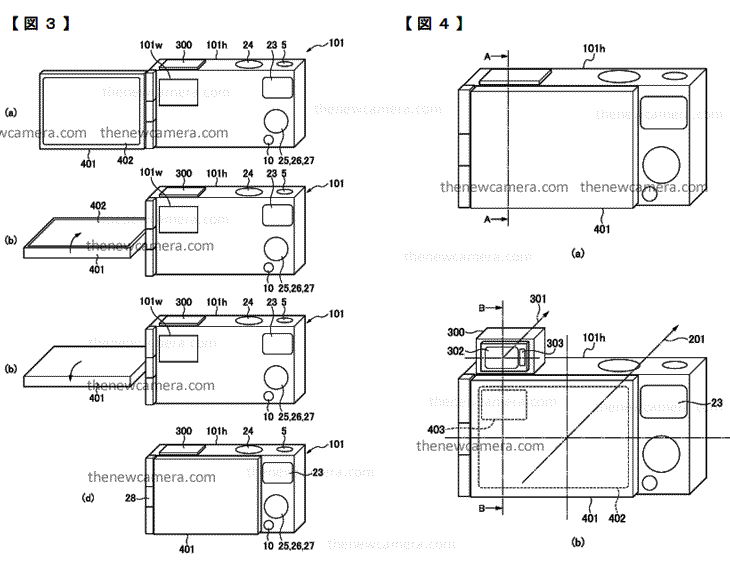
A Bold Setup Design
After closely looking at all the patents, I feel that Canon wants to create a big leap with the help of their AI tech to reintroduce compact cameras with a massive comeback. Canon seems intent on integrating the best of both worlds, such as an advanced electronic viewfinder in a compact camera alongside a versatile flip display screen.
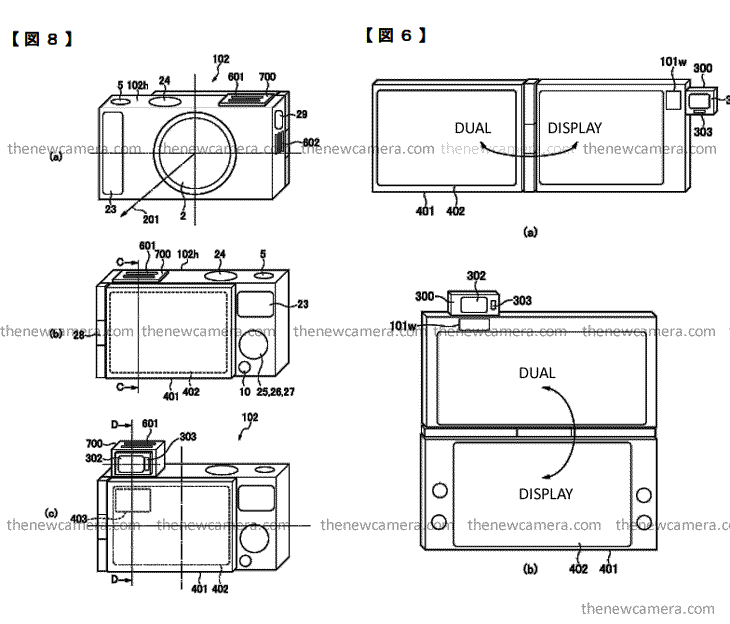
Why This Product Blew Our Minds
This patent was completely unexpected. After reading it, it blew our minds to see Canon’s jaw-dropping innovative designs from Canon engineers. Canon is creating a variety of designs, such as a retractable EVF system, one that slides out, and another that rotates parallel to the camera body, Dual Display System based cameras. These different designs show that Canon is working on multiple prototypes of compact cameras.
So, Now We came to know that the CANON research and development team still working on innovative compact cameras. As we reported earlier, the demand for compact cameras is again on the rise. Right now, even Canon’s older compact models still in production cover 60% of the compact market in Japan. It’s exciting to see Canon compact cameras making a return, with more innovative designs and unique features.
What’s Next for Canon’s Hybrid Compact Cameras?
The patent makes it very clear that these cameras are being designed for modern-day vloggers and photographers. Canon is pushing boundaries by creating cameras with huge market potential.
Canon is Gearing Up for the Future
With advancements in AI technology, high-performance chips, and the Canon DIGIC accelerator (Canon’s own home-grown AI chip), Canon is going back to basics to develop a compact camera that is portable, powerful, and blogging-ready. At the same time, it will be an excellent tool for photographers.
Canon seems to be creating a compact hybrid camera setup that everyone—whether a content creator or a photographer—will wish to have.
also see – Canon Upcoming Cameras 2025 – See more Canon patents
Application JP20XX events 2023-04-20
Application filed by Canon In c2024-10-31
Publication of JP20XX
Status Pending
Information available on request
Get LIVE RUMORS –> FACEBOOK | TWITTER | INSTAGRAM to get live news + Canon rumors 24X7
The post Announced: Canon Compact Camera Breakthrough: This Patent Hints at the Ultimate Hybrid Design! appeared first on thenewcamera.com
By admin, on November 15th, 2024
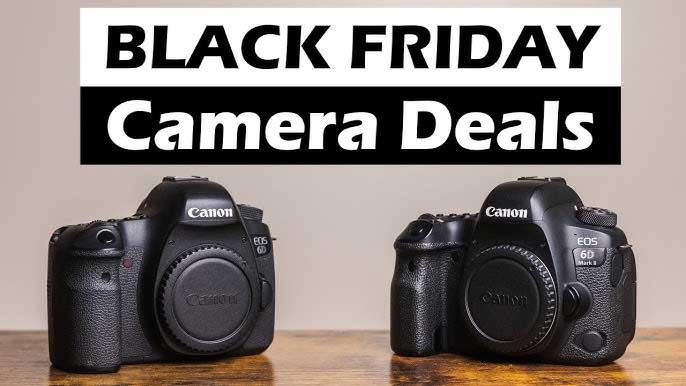
We have selected some of the best Canon mirrorless and DSLR camera BLACK FRIDAY DEALS 2024 throughout the Amazon and B&H stores, and this page will be continuously updated with more deals and offers. If you’re interested in buying a new Canon camera this Black Friday, this page is undoubtedly very important for you.
Best CANON Cameras and Lenses BLACK FRIDAY Deals 2024
|
Deal Content |
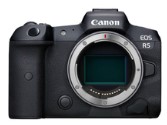 |
Canon R8 Was $1499 | Now $1199
Canon R8 is an excellent entry-level full-frame mirrorless camera with almost the same features as the Canon R6 II, you will be getting the same 24.2 MP FF CMOS sensor, 4k 60fps uncropped video, and 40fps cont. shooting speed. |
 |
Canon EOS R5 | was $3,899 | now $2,799
Save $1,100 at Amazon, the camera captures an exceptional amount of detail with its 45MP sensor, the image quality is so good you can compare it with Sony’s latest BSI CMOS sensors. The original 8K powerhouse is nearly a grand off – a stunning saving! With its 45MP stills and hi-res video capabilities, this is the best camera for all-purpose shooting. |
 |
Canon EOS R6 Mark II + RF 24-105mm | was $3,599 | now $3,099
Save $500 at Amazon In our review – The Canon R6 Mk II camera is an allrounder camera, that can be used for sports, weddings, travel, and wildlife, only lens requirements will change from time to time. It’s Canon’s fastest camera and, with more AF tracking modes, it’s a real beast. Throw in the 24-105mm, this deal is incredible. |
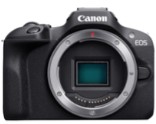 |
Canon EOS R100 twin lens kit | was $829.99 | now $499
Save $330.99 at Amazon With a 24.2MP sensor, a viewfinder and advanced autofocus, the Canon R100 is a good camera for entry-level photographers out there, The RF-S 18-45mm f/4.5-6.3 and RF-S 55-210mm f/5-7.1 lenses are both image-stabilized, for smooth shooting. |
 |
Canon EOS R100 | was $479 | now $299
Save $180 at B&H Grab this amazing entry-level mirrorless for a steal, at this price with 4K video and 24MP still, but keep in mind its body only so later on you have to buy lenses. |
 |
Canon EOS Rebel T100 + 18-55mm lens | was $379 | now $339
Still interested DSLRs ? Save $40 at B&H This is the cheapest DSLR kit that you can get, and comes with a non-stabilized 18-55mm. Bets way to start learning photography when you dont want to invest much. |
 |
Canon 5D Mark IV + 24-105mm | was $3,399 | now $2,899
Get Pro DSLR camera and Super Reasonable price – Save $500 at B&H Canon’s workhorse DSLR packed by a powerful 30.4MP full frame sensor and 4K 30p video capability. |
Is Black Friday the best time to buy a Canon camera?
Yes, if you’re interested in buying a camera, this is the time when mirrorless cameras are at their lowest prices, especially during November.
We’ve also included the price before and after discounts in the list, so you can easily see the original price you’d expect to pay after the deal period ends versus the current deal price. Both prices are listed in the deal’s heading.
When does Black Friday start?
Black Friday technically starts on November 29, but as you know, companies begin offering discounts as soon as November begins. Right now, we’re seeing some of the deepest discounts available on all the products mentioned.
Some websites, like B&H, also offer cashback options. Additionally, there’s a zero-percent interest offer specifically for Sony or Nikon Cameras if you take a loan for a camera within a one-year period.
By admin, on November 9th, 2024
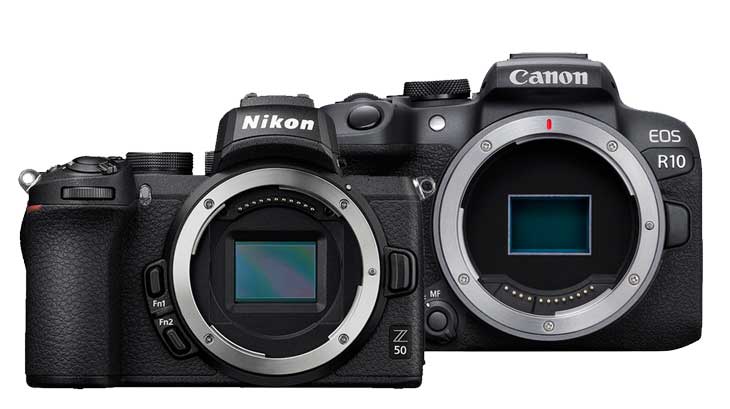
Let us compare the Nikon Z50 II with the Canon R10 camera. Let’s explore the main differences between these two cameras and find out which one is the best for photographers and which one is best for shooting videos. In the comparison table below, we have highlighted the differences in design, and we have created two separate tables dedicated to photography and videography features. So let’s find out the best camera between these two for your specific needs and budget.
1. Design Comparison
| Feature |
Nikon Z50 II |
Canon R10 |
| Body Dimensions |
5 x 3.8 x 2.6″ / 127 x 96.8 x 66.5 mm |
4.8 x 3.5 x 3.3″ / 122.5 x 87.8 x 83.4 mm |
| Weight |
495 g (Body Only) |
382.2 g (Body Only) |
| Lens Mount |
Nikon Z |
Canon RF |
| Display |
3.2″ Tilting Touchscreen LCD, 1,040,000 Dot |
3.0″ Free-Angle Tilting Touchscreen LCD, 1,040,000 Dot |
| EVF Type |
Built-In Electronic (OLED), 0.39″, 2,360,000 Dot – 1000 NITS Brightness |
Built-In Electronic (OLED), 2,360,000 Dot |
| Battery Type |
EN-EL25a or EN-EL25, approx. 230 shots |
LP-E17, approx. 430 shots |
| Ports |
USB-C Data & Power, Micro-HDMI, Mic & Headphone Jacks |
USB-C, Micro-HDMI, Mic Jack |
| Available Lenses |
Nikon Z DX and FX lenses |
Canon RF-S and RF lenses |
2. Photographic Feature Comparison
| Feature |
Nikon Z50 II |
Canon R10 |
Sensor Type
|
BSI CMOS |
FSI CMOS |
| Sensor Size |
23.5 x 15.7 mm (APS-C) |
22.3 x 14.9 mm (APS-C) |
| Effective Resolution |
20.9 Megapixel |
24.2 Megapixel |
| ISO Range (Photo) |
100 to 51,200 (Extended: 100 to 204,800) |
100 to 32,000 (Extended: 100 to 51,200) |
| Shutter Type |
Mechanical Focal Plane, Electronic Rolling |
Mechanical, Electronic Rolling |
| Shutter Speed (Mechanical) |
1/4000 to 900 sec |
1/4000 to 30 sec |
| Bulb Mode |
Yes |
Yes |
| Continuous Shooting (Mech) |
Up to 11 fps at 20.9 MP |
Up to 15 fps at 24.2 MP |
| Continuous Shooting (Elec) |
Up to 30 fps at 20.9 MP (JPEG) |
Up to 23 fps at 24.2 MP |
Pre-Capture Mode
|
1 Sec |
0.5 Sec |
| Autofocus Points |
231 (Phase & Contrast Detection) |
651 (Phase Detection Zones) |
| AF Sensitivity |
-9 to +19 EV |
-4 to +20 EV |
| AF Modes |
Continuous-Servo AF, Full-Time AF, Manual, Single-Servo AF |
Continuous-Servo AF, Manual, Single-Servo AF |
Weather sealed
|
Yes |
No |
Battery Life
|
250 Shots |
450 Shots |
3. Video Comparison
| Feature |
Nikon Z50 II |
Canon R10 |
| Sensor Type |
BSI CMOS |
FSI CMOS |
| Video Resolution & Frame Rates |
UHD 4K (30 fps) Uncropped |
UHD 4K (30 fps) Uncropped |
4k 60 FPS
|
1.5X Cropped |
1.5x Cropped |
Full HD Max Frame rate
|
120 FPS |
100 FPS |
Product showcase mode
|
Yes |
No |
| Video Stabilization |
Digital (Video Only) |
Digital (Video Only) |
| Internal Recording Codec |
H.264/H.265 (8/10-Bit) |
H.264 MP4 4:2:0 8-Bit, H.265 MP4 4:2:2 10-Bit |
| External Recording Codec |
HDMI 4K |
HDMI 1080p |
| HDR/LOG Support |
HDR-HLG, Nikon N-Log |
HDR-PQ |
Support RAW Video
|
Yes, N-Log available |
No, C-Log isn’t there |
| Recording Limit |
Up to 125 minutes |
Upto 120 Mins |
| Audio Recording |
Stereo, 24-Bit 48 kHz LPCM or 16-Bit AAC |
Stereo, 2-Channel AAC |
Conclusion Verdict
The Nikon Z50 II camera now has much-improved autofocus and also a low-light sensor, which helps to extract the maximum amount of detail possible in uncontrolled lighting environments or in any outdoor location. For wedding and event photography, we recommend you to go with Nikon Z50 II
Now, for sports and wildlife, it depends on which camera you like to buy since both are very capable. But again, due to the presence of a BSI CMOS sensor, the Z50 Mark II camera will perform better in uncontrolled lighting environments, specifically when you are using this camera for wildlife or bird photography. However, for sports events, you can take the Canon R10 with you when there is no big issue with light, as sports events generally happen during daylight. So, you may utilize the R10, and also, in sports events, you may require more reliable autofocus tracking, which is present in the Canon R10 alongside its slightly faster 15 fps mechanical shutter.
For day-to-day usage and street photography, I am going to recommend the Nikon Z50 Mark II camera. Due to the nature of its sensor and construction, the camera is able to capture clear shots and also has high low-light autofocus sensitivity compared to the R10. So more or less, for uncontrolled lighting environments of any type, the Nikon Z50 Mark II is more recommended. 165
Get a Nikon Z50 Mark II camera from the B&H Store | Amazon.com
Canon R10 – Camera body $879 [B&H Store] [Amazon.com] |
| Type of Photography/Video |
Recommended Camera |
| Wedding and Event Photography |
Nikon Z50 II
Due to its improved autofocus, low-light sensor, and availability of third-large amount party lenses , we recommend you to go with Nikon Z50 II |
| Wildlife and Bird Photography |
Nikon Z50 II
The BSI CMOS sensor in the Z50 II performs well in low-light and uncontrolled lighting, which is often required in wildlife photography. + You get AF sensitivity down to – 9 FV and upscaled 3d AI AF tracking. |
| Sports Photography (Daylight Events) |
Canon R10
Reliable autofocus tracking and slightly faster 15 fps mechanical shutter make the R10 a strong choice for sports events in daylight conditions. |
| Everyday Use and Street Photography |
Nikon Z50 II
Excellent low-light autofocus sensitivity and sensor design allow the Z50 II to capture clear shots in diverse lighting, making it versatile for daily use. |
| General Video Needs |
Canon R10 (for daylight, faster autofocus)
OR Nikon Z50 II (for low-light video) |
Nikon Z50 II Image Quality Test
Nikon Z30 / Zfc Image samples have been taken here since Nikon Z50 II and Zfc, both of them share the same sensor, so image quality is expected to remain exactly same as of the Nikon Z50 Mark II. Image credit dpreview.com
In the Image below we have compared the Nikon Z30 vs Canon R10 Images at ISO 25600, in RAW mode, as you can see the details are much preserved in Nikon Z50 II file
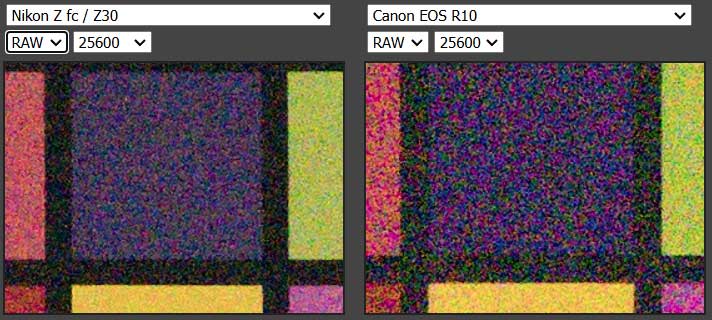
Next comparison Even in the JPEG comparison below you can see that Nikon is preserving more details compared to the Canon R10 FSI CMOS sensor.
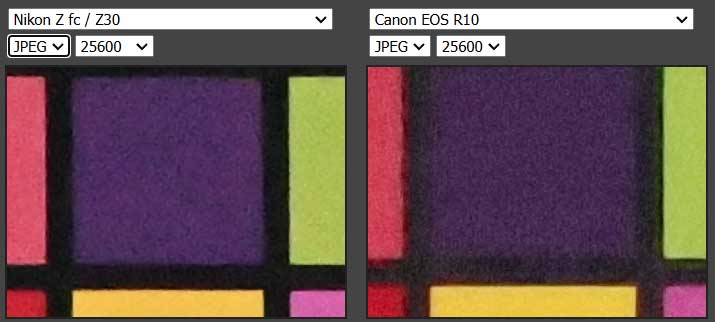
During the base ISO test we can see the letters in the Nikon Z50 II are more clearly visible than those of the Canon R10, despite having higher resolution Canon isn’t able to extract the amount of details they should at the base ISO range
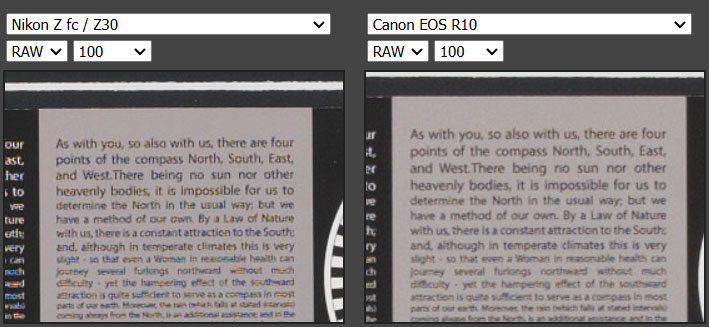
In the JPEG Mode, the performance of the Canon R10 Camera is much improved which may be due to JPEG filters the Nikon Z30 sample at base ISO losing a bit of details which was visible in the RAW Mode.
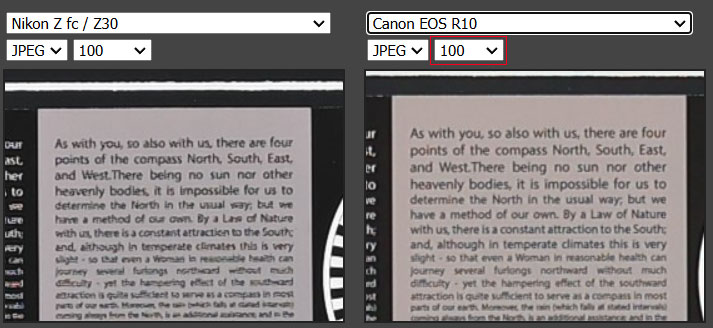
Verdict / Conclusion Image Quality
In terms of image quality, the Nikon Z50 II performs better than the Canon R10 at higher ISO settings, particularly when shooting in RAW mode. The Nikon Z50 II (or Z30) tends to capture more details at higher ISOs due to its 20MP sensor and lack of a low-pass filter, which helps to maintain fine textures.
However, at base ISO, when shooting in JPEG, the Canon R10 may show slightly more detail due to its higher 24MP resolution. But if you’re shooting in RAW at base ISO, the Nikon cameras can still provide a slightly clearer picture due to the low-pass-less design, which can enhance sharpness. Overall, for detail preservation, the Nikon Z50 II’s 20MP sensor has a slight edge, especially for those who prioritize high ISO performance and RAW shooting.
Support us – Use or affiliate link Amazon.com | B&H Store for the next purchase u make – it helps us
Follow us on our social pages FACEBOOK | TWITTER | INSTAGRAM to get live Camera News +
|
KEEP THIS BLOG ALIVE - Support New Camera Buy Canon Lenses, Buy Music CD or Digital Camera at amazon it helps this site, and you do not pay anything extra, it is just a way to help support this site.

|





















